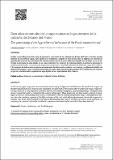Por favor, use este identificador para citar o enlazar a este item:
http://hdl.handle.net/10261/102765COMPARTIR / EXPORTAR:
 SHARE SHARE
 CORE
BASE CORE
BASE
|
|
| Visualizar otros formatos: MARC | Dublin Core | RDF | ORE | MODS | METS | DIDL | DATACITE | |

| Título: | Ten years study of the hygrothermal behaviour of the Prado museum’s roof |
Otros títulos: | Diez años de estudio del comportamiento higrotérmico de la cubierta del Museo del Prado | Autor: | Sánchez-Montero, Javier CSIC ORCID; Fullea, J. CSIC ORCID; Sotorrío Ortega, Guillermo CSIC ORCID; Rentero, Gabriel CSIC; Andrade Perdrix, Carmen CSIC ORCID ; Linares-Alemparte, P. CSIC ORCID ; Barroso, J. CSIC | Palabras clave: | Sensor Monitoring Roof Prado Museum Sensores Monitorización Cubiertas Museo del Prado |
Fecha de publicación: | 2014 | Editor: | CSIC - Instituto de Ciencias de la Construcción Eduardo Torroja (IETCC) | Citación: | Informes de la Construcción 66(535) e027 (2014) | Resumen: | [EN] In the current paper we present the results of the monitoring of the hygrothermal behaviour during the last ten years of the El Prado Museum roof. Sensors were installed in the south roof of the museum after it underwent mayor repair following a leak over a very important exhibition hall (the one holding Velazquez’s Las Meninas painting). The liquid water sensors reveal that water is retained at the waterproofing layer. These sensors do not show water presence in lower layers of the roof. The humidity sensors show condensation when the ambient temperature drops. The temperature sensors show the insulating capacity of the different layers of the roof, which effectively attenuate the outside temperature changes. The strain sensors placed on the liquid waterproofing layer show a constant increase of strain with time. In summary, the repaired roof can be considered to perform as intended and no more leaks have been detected. [ES] Debido a unas filtraciones detectadas al terminar la renovación de las cubiertas del Museo del Prado se decidió instalar sensores en sus diversas capas, cuyo diseño no es tradicional. Después de más de diez años de registro, los sensores de agua líquida muestran la acumulación de humedad en la capa de impermeabilización líquida. Sin embargo, no se ha detectado la presencia de agua líquida en las capas inferiores. Los sensores de humedad relativa muestran la presencia de condensaciones locales. Los sensores de temperatura muestran la capacidad aislante de las diferentes capas de la cubierta. Y los sensores de deformación muestran un incremento de deformación continuo con el tiempo, posiblemente debido a la fluencia del conjunto. Como conclusión del estudio, se puede afirmar que el comportamiento de la cubierta ha sido correcto ya que no se ha detectado la aparición de agua líquida en las capas internas de la cubierta. |
Versión del editor: | http://dx.doi.org/10.3989/ic.12.121 | URI: | http://hdl.handle.net/10261/102765 | DOI: | 10.3989/ic.12.121 |
| Aparece en las colecciones: | (IETCC) Artículos |
Ficheros en este ítem:
| Fichero | Descripción | Tamaño | Formato | |
|---|---|---|---|---|
| Informes de la Construcción 66(535) e027 (2014).pdf | 1,85 MB | Adobe PDF |  Visualizar/Abrir |
CORE Recommender
SCOPUSTM
Citations
2
checked on 01-abr-2024
WEB OF SCIENCETM
Citations
2
checked on 23-feb-2024
Page view(s)
314
checked on 23-abr-2024
Download(s)
239
checked on 23-abr-2024
Google ScholarTM
Check
Altmetric
Altmetric
NOTA: Los ítems de Digital.CSIC están protegidos por copyright, con todos los derechos reservados, a menos que se indique lo contrario.
